| Pages:
1
2 |
Edward Powell
Oud Junkie
    
Posts: 1212
Registered: 1-20-2008
Member Is Offline
Mood: g'oud
|
|
plywood ribs?
Quote: Originally posted by jdowning  | We are talking here about acoustic not electrical instruments. Veneered necks and pegboxes are, of course, traditional practice.
Plywood is a very stable material. The geometry of an oud bowl - is like an egg shell - very rigid and strong once assembled from individual ribs so I
very much doubt if there would be any significant acoustic difference between one made from ribs of Beechwood aircraft plywood and one made of ribs
from rosewood or any other materials all else - like the volume of the bowl - being equal (apart from the cost!). It is the sound board and bracing
that are of primary importance acoustically.
I have heard of pine being used historically for lute bowls but have never found an extant example - probably because softwoods are more difficult to
hot bend than most hardwoods.
For stability, 3 piece (3ply) plywood is usually constructed with the grain of the centre core at right angles to that of the outer laminations. Also
when veneering a piece of wood both front and back faces must be veneered to counterbalance shrinkage forces and prevent 'cupping' of the work - at
least if a traditional hot hide glue 'iron on' procedure is used.
Plywood can be hot bent.
Food for another topic, however, that I might initiate with my experience in building the 'Grobert' guitar - before memory completely fades.
|
I think u might have the answer there... when I veneered 3 (0.6mm) strips of mahogany into one rib they seemed a bit flimsy across the width. But the
idea to make the middle layer a bit thicker and with the grain perpendicular to the outer layers - this would certainly stiffen up the rib for
sure.
I tend to agree that the back material is not affecting the sound too much - otherwise how would those heavily jewelled egyptian ouds ever get a
decent sound???
|
|
|
fernandraynaud
Oud Junkie
    
Posts: 1865
Registered: 7-25-2009
Location: San Francisco, California
Member Is Offline
Mood: m'Oudy
|
|
I dunno, but I am not surprised the heavy backs can give a good sound. I've said this before, but here it is, for our newer members. I have two
Sukars, a model 212 and a model 14. Sukar has worked out a template that his ouds generally follow. These two are very similar ouds, made around the
same time, same dimensions, same bracing, same soundboard, fingerboard, same bridge, pegs, same paper strips inside, you name it. In most ways they
are almost twins. I expected them to sound about the same. But they sound and emote very differently.
I've never weighed them but the 212 feels lighter, the 14 feels heavier. The 212 bowl is a medium colored grey walnut, not the reddish stuff, with,
what do you call it, thin separating purfling(?) stripes between the ribs. The 14's bowl is a dark wood that some have identified as "pretty sure it's
ebony", a Sukar reseller in Damascus identified specific Sukars as being ebony, while others have said Sukar never uses ebony except the pegs, and
maybe those very dark fingerboards on the high end models like the 211, 212, 14, etc. On the Sukar site I could decipher it only as as "walnut of
lions". Some have called it "oily dark walnut". I don't know. Who cares. The fact remains it's a much darker wood, and feels heavier. But the ouds are
otherwise so similar it's a rare opportunity to isolate the effect of the bowl. Most comparisons are apples to oranges, altogether different
instruments.
The 212 is at home in major chords, and maqamat like Ajam, Rast. The 14 is at home in deep soulful minor scales/modes, isn't so good with chords,
loves Hijaz, Saba, Nahawand. The 212 is bright, shines and twinkles (as other 212 owners have agreed), the 14 bellows and moans, has a stronger bass.
If you play the two you immediately feel it, it's intuitively obvious that one is "heavier and darker" in timbre and character, and what is most
different in the construction is: the bowl material itself.
I don't think there's anything wrong with composite materials, or outright synthetics, but an Ovation fiberglass back guitar has a specific sound, and
after my experience with these two otherwise so similar Sukars, I must reject the "no effect of the bowl material" story.
|
|
|
Edward Powell
Oud Junkie
    
Posts: 1212
Registered: 1-20-2008
Member Is Offline
Mood: g'oud
|
|
ragmakamtars version 9 and 12 are almost identical but the bowl wood is totally different - #9 is maple, #12 is merbou... merbou is extremely hard
and hard to work with. There were enough differences in design to alter the sound - but in fact the sounds were WORLDS APART. I wonder how much the
merbou changed the tone... I think I will not use merbou for bowls.
ragmakamtar #11 is rosewood and the bass is HUUUUUGE... but then the bowl is enormous also.
finally there are so many factors that we will never know for sure - that's what makes luthiery such a mystery.
PS - let me add that ragmakamtars 9 and 10 used exactly the same wood and body shape... but also had totally different sounds. The design differences
were:
1) 10 had all round much lighter construction on everything
2) 10 had larger soundhole and 2 ribs less (bowl less deep)
3) 10 had one neck much longer
...so the wood was identical but sound totally different obviously from design differences.
|
|
|
fernandraynaud
Oud Junkie
    
Posts: 1865
Registered: 7-25-2009
Location: San Francisco, California
Member Is Offline
Mood: m'Oudy
|
|
But my two Sukars are so similar that it gives us that rare opportunity to reduce the variables! Oh, and I even coated the soundboards exactly the
same with egg white. I ordered them out of Damascus with the thought that I might sell one. But they are so different that THAT brilliant idea sure
bit the dust. I kept playing them to try to decide which one to keep, after all it was too costly to keep both. But the more madly I played and
compared them, the more they diverged! Aiii Caramba, dolor des dollares! Never do that unless you really want two ouds! So I kept them and ended up
selling my Model 1 that was different yet, but sort of in-between. But there was something about a Shehata. Danger, danger! The number of ouds per
household is mathematically almost impossible to reduce.
|
|
|
fernandraynaud
Oud Junkie
    
Posts: 1865
Registered: 7-25-2009
Location: San Francisco, California
Member Is Offline
Mood: m'Oudy
|
|
"nnno!" he said, making little spirit-chasing-away gestures and looking about nervously for something to grab onto. (that was in response to Edward's
question, as to whether I had a Faruk oud).
|
|
|
Aymara
Oud Junkie
    
Posts: 1162
Registered: 10-14-2009
Location: Germany / Ruhr Region
Member Is Offline
Mood: No Mood
|
|
Sorry, Edward, but I highly doubt that. I believe, that the wood choice for the bowl highly influences the sound.
See what I reported about my personal oud choice in THIS thread at the beginning of page two.
So Fernand is not the only one with such experiences 
Greetings from Germany
Chris
|
|
|
fernandraynaud
Oud Junkie
    
Posts: 1865
Registered: 7-25-2009
Location: San Francisco, California
Member Is Offline
Mood: m'Oudy
|
|
But I'll say one more thing. What I'm noticing most is the different "personality" of two instruments which are as close to clones as we get with
ouds, because of Sukar's standardized production techniques. I don't think it's as simple as "heavier wood makes more bass". I don't know if it's
something you'd immediately see on a spectrum. There's something about the overall "character" of a good instrument that is very strong, and if we
think in terms of frequency response, we might say it's got more of this or that frequency spectrum, when in reality that's just part of a more
complicated picture.
Those who say that technically the spectrum isn't as affected by the material of the bowl may be right too.
But the totality of the instrument forms that character, including the bowl. And maybe you even can't help but play each instrument differently, in
accordance with how you perceive its character, and that might lead you to interpret, to abridge, that by saying this one is brighter, or bassier, or
whatever. Then how you interact with it, how you play it, might also literally affect how the wood settles, how it, as we say, "opens up", so in a
circular way your impression reinforces itself. And that's before invoking more metaphysical formulations (that we're not very well equipped to
discuss), like "a player becomes his instrument", and vice versa.
|
|
|
jdowning
Oud Junkie
    
Posts: 3485
Registered: 8-2-2006
Location: Ontario, Canada
Member Is Offline
Mood: No Mood
|
|
Ho hum! So how about the practicalities of using plywood (either as a commercially available product or made up from exotic veneer) as a material for
bowl construction? That is the question posed by Edward!
|
|
|
Edward Powell
Oud Junkie
    
Posts: 1212
Registered: 1-20-2008
Member Is Offline
Mood: g'oud
|
|
Quote: Originally posted by Aymara  |
Sorry, Edward, but I highly doubt that. I believe, that the wood choice for the bowl highly influences the sound.
|
...but read carefully, I do think wood choice affects the sound but "not too much".
I think saying that the wood choice (as long as we stay within the range of commonly used hard woods) "highly influences the sound" is an
exaggeration. And furthermore, as John and I pointed out, your and Fernie's experiments, while very interesting, can't be held as conclusive because
small variation in soundboard can alter the sound very much.
But this is a very useful dialogue and everyone's opinion and experience is valuable.
|
|
|
jdowning
Oud Junkie
    
Posts: 3485
Registered: 8-2-2006
Location: Ontario, Canada
Member Is Offline
Mood: No Mood
|
|
As I do not throw anything away that might find a future used I have this morning found my original molds as well as a set of laminated side rib
blanks for a copy that I made of the circa 1820 Grobert guitar (Mirecourt 1794 - 1869) cat# E.375 C.278 that at that time was located in the Musee
Instrumental du Conservatoire National Superieur de Musique de Paris. The Museum working drawing and notes by Pierre Abondance dated 1982 indicate
that the guitar was once owned by virtuoso violinist and guitar player Paganini and then passed on to renowned French musician and composer Hector
Berlioz.
The sides of the guitar body are made from sawn Rio Rosewood (Brazilian Rosewood) of thickness from 1.0 to 1.2 mm.
The back - of Brazilian Rosewood - is a laminate of 0.6 mm thick sawn rosewood veneer glued to a backing of 'mediocre quality' softwood - average
total thickness of the back being about 2.3 mm.
I did not have any solid Rio rosewood for the sides so they were made up from a 3-ply laminate of Rio rosewood veneer with a mahogany veneer core. The
glued laminates were then formed experimentally by conventional hot bending as well as by cold forming in a mold.
I have also used commercially available plywood - hot bent - to make lute cases.
More to follow on this experience.
|
|
|
fernandraynaud
Oud Junkie
    
Posts: 1865
Registered: 7-25-2009
Location: San Francisco, California
Member Is Offline
Mood: m'Oudy
|
|
One man's ho' is another man's hum. I didn't realize the timbre of ouds had been fully elucidated and we were down to technicalities.
|
|
|
jdowning
Oud Junkie
    
Posts: 3485
Registered: 8-2-2006
Location: Ontario, Canada
Member Is Offline
Mood: No Mood
|
|
Then perhaps you did not read or understand the title of this topic fernandraynaud? It is all about the technicality of plywood ribs and not at all
about elucidating oud timbre is it? The latter would seem to be part of the ongoing discussion that you are already participating in on the forum
topic " which wood's the best "?
|
|
|
fernandraynaud
Oud Junkie
    
Posts: 1865
Registered: 7-25-2009
Location: San Francisco, California
Member Is Offline
Mood: m'Oudy
|
|
Perhaps.
|
|
|
Aymara
Oud Junkie
    
Posts: 1162
Registered: 10-14-2009
Location: Germany / Ruhr Region
Member Is Offline
Mood: No Mood
|
|
Is plywood more difficult to bend? I would expect that, but never tried.
Greetings from Germany
Chris
|
|
|
jdowning
Oud Junkie
    
Posts: 3485
Registered: 8-2-2006
Location: Ontario, Canada
Member Is Offline
Mood: No Mood
|
|
Watch this space!
|
|
|
jdowning
Oud Junkie
    
Posts: 3485
Registered: 8-2-2006
Location: Ontario, Canada
Member Is Offline
Mood: No Mood
|
|
It is some time now since I have hot bent commercially available plywood so a quick trial was undertaken this morning to demonstrate bending of two
strips of Meranti 3 ply of 5.2 mm thickness from my scrap pile.
Meranti plywood is about as cheap as it gets - a utility plywood for general purpose work.
Using a heavy duty propane heated bending iron and moistening the surfaces with water, the long strip (with the grain of the thin external veneers
running longitudinally and the thicker core wood cross grain) the wood was bent very easily. Some compression damage (crumpling) of the internal
veneer was noted.
The smaller sample with the external veneers cross grained and the core grain longitudinal was more difficult to bend - partly because the test piece
was so short (about 5 inches in length).
The bent pieces remained stable after bending with no sign of delamination of the veneers.
I have used hot bent Meranti plywood 2.7 mm thick for making lute cases - see " Build an Authentic Oud Case" on this forum for the full story. Note
that the bent staves of the lute case have the grain of the external veneers running cross wise.
Cheap Meranti plywood is, of course, not recommended for making oud ribs (this is just to demonstrate what can be done) - but high grade thinner
plywoods such as those made from Birch (aircraft grade) or Mahogany (marine grade) - have not been tested but would likely give good results. The
thinner grades might also be veneered with any type of hardwood veneer prior to bending into the ribs of a bowl.
Note that due to the thinness of the external veneers, bowl ribs would have to be accurately fitted with no significant 'step' between adjacent ribs
and that it would not be possible to produce a rounded external profile of a bowl. The bowl would have a faceted profile like that of a lute - not an
unattractive feature that would have the added benefit of reducing slipping or sliding tendency of a bowl when an oud is being held.
Next to review past experience in laminating Brazilian rosewood veneers in order to construct a 'copy' of the 19th C Grobert guitar that may also have
some application to laminated ribs for oud bowl construction.
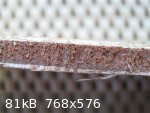
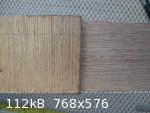
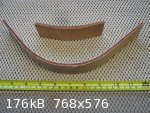
|
|
|
Edward Powell
Oud Junkie
    
Posts: 1212
Registered: 1-20-2008
Member Is Offline
Mood: g'oud
|
|
thanks John
this is cool and very interesting... I'm surprised that it is so easy to bend 5mm thick stuff!
My own idea was rather not to bend plywood but to 'make' plywood around a form, so the rib will end up having the exact shape it needs to be...
thereby saving the builder the task of accurately bending the rib. I did this already and it worked really well --- I used contact cement but I think
this is not a good idea because that glue does not dry brittle --- you mentioned using hide glue then ironing the veneer.... would this super heating
of the glue cause an instant curing of the glue?
|
|
|
jdowning
Oud Junkie
    
Posts: 3485
Registered: 8-2-2006
Location: Ontario, Canada
Member Is Offline
Mood: No Mood
|
|
Hot bending of commercially available plywoods was just to demonstrate that it can be done.
I agree that a good method is to lay up the glued veneer on a caul or mold and then clamp in place (cold) until the glue dries.
This is the method that I finally used for the sides of the Grobert guitar as we will see.
However, I did also experiment with cold gluing the laminates as a flat sheet and then hot bending the sides in the usual manner - which also works.
For this I used PVA glue for laminating as it is thermoplastic - temporarily softening with heat.
So it is possible to use both methods although if a 3 dimensional shape is required (like the back of an archtop guitar or plywood furniture), a stack
of separate glued laminations would be required which are then formed on a mold under high pressure and temperature.
Hot hide glue was used for centuries past (and still is) for veneering. The glue will temporarily remelt as long as the temperature is not too high.
This is the method that I used for laminating the back of the Grobert guitar.
A modern alternative is to coat both surfaces with PVA glue let it dry and then iron the the laminates together with a hot household iron.
|
|
|
Brian Prunka
Oud Junkie
    
Posts: 2939
Registered: 1-30-2004
Location: Brooklyn, NY
Member Is Offline
Mood: Stringish
|
|
Would it be possible to use a vacuum press to assist in this process? I know in some archtop guitars they use a vacuum press and a mold to bend the
plywood guitar top into the desired shape. I believe they do this during the gluing of the plywood.
Obviously, an oud has a much more dramatic degree of bending than an archtop guitar, so it may not be practical.
|
|
|
jdowning
Oud Junkie
    
Posts: 3485
Registered: 8-2-2006
Location: Ontario, Canada
Member Is Offline
Mood: No Mood
|
|
Yes a vacuum press can be used to apply a uniform pressure to laminates being formed over a mold.
For an oud bowl though we are here only considering forming the individual ribs from laminates that would then be assembled edge to edge in the usual
way. That, of course, is a much simpler procedure than attempting to form the bowl as a one piece laminate (although it likely could be done by laying
up veneer strips over a solid mold in the way strip built canoes are fabricated - rather like papier mache only using veneer instead of glued paper
strips).
|
|
|
jdowning
Oud Junkie
    
Posts: 3485
Registered: 8-2-2006
Location: Ontario, Canada
Member Is Offline
Mood: No Mood
|
|
Here for information are some images of my 'copy' of the Grobert guitar made over fifteen years ago for a Canadian national 'live history' museum for
performance of 19th C music.'
Note the beautiful figuring of the laminated Brazilian rosewood veneered sides and back and the spruce inner wood of the back.
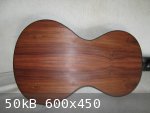
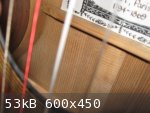
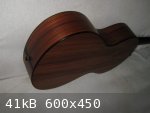
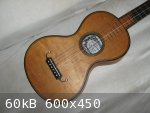
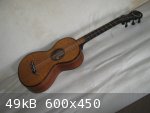
|
|
|
Edward Powell
Oud Junkie
    
Posts: 1212
Registered: 1-20-2008
Member Is Offline
Mood: g'oud
|
|
this is a bit off topic, but John, I have a couple of old guitars I bought in CZ over ten years ago and they majorly resemble this guitar you have
made --- I just wonder if you have any info on these guitars.... see pics
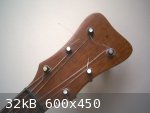
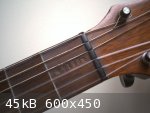
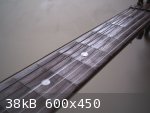
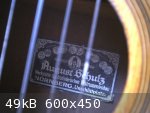
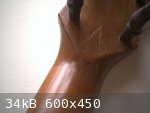
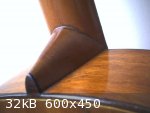
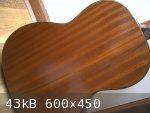
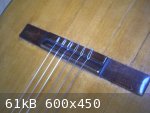
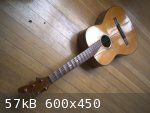
|
|
|
Edward Powell
Oud Junkie
    
Posts: 1212
Registered: 1-20-2008
Member Is Offline
Mood: g'oud
|
|
and this next guitar....
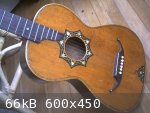
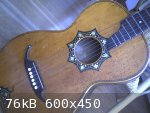
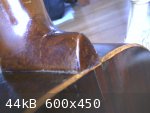
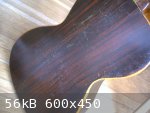
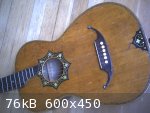
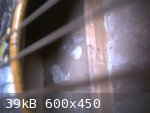
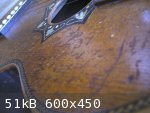
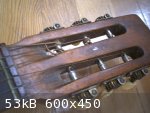
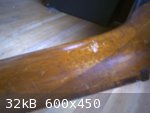
|
|
|
Edward Powell
Oud Junkie
    
Posts: 1212
Registered: 1-20-2008
Member Is Offline
Mood: g'oud
|
|
BTW... your 'copy' is amazing... did u use veneer simply to save $$$?
|
|
|
jdowning
Oud Junkie
    
Posts: 3485
Registered: 8-2-2006
Location: Ontario, Canada
Member Is Offline
Mood: No Mood
|
|
Nice old guitars Edward with some interesting details. They appear to be larger bodied and more heavily built than the French style Grobert guitar
which was gut strung played 'finger style' with soft fingertips. These look as though they are more heavily strung intended for sounding with a pick
or plectrum - either wire strung or heavy gauge gut/wound silk.
Interestingly the fingerboard of the first German guitar is 'scalloped' (between the frets) a feature seen much earlier on wire strung instruments
like the cittern - in order to keep the action as low as possible and minimise intonation problems as the strings are stopped. The second guitar has
machine heads of the type used for metal strings.
For these reasons I do not think that these guitars closely resemble the French style guitars and may be from a later period (late 19th C early 20th C
?) - but I do not know enough about this type of guitar to be sure.
For the Grobert copy I tried - as far as possible - to replicate the construction and materials of the original. The original has a 2 ply back of sawn
Rio rosewood veneer on softwood about 2.4 mm total thickness and sides (ribs) of solid sawn Rio rosewood about 1 mm thick. I had to use knife cut Rio
rosewood veneer for the copy because that is all that was available - although if I had been able to obtain sawn Rio rosewood at the time no doubt the
cost would have been prohibitive (and its procurement illegal!).
So the compromise was knife cut veneer on Sitka spruce for the back and a double thickness of knife cut veneer for the sides.
More on that to follow.
|
|
|
| Pages:
1
2 |